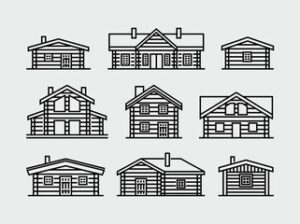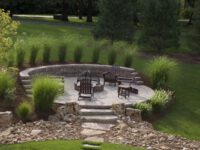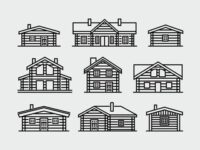Log Home Design
Log and timber homes have a very distinct look. Some are two stories with large gables and a classic wraparound porch. Others feature long, low rooflines.
Most of these homes employ walls of windows that flood rooms with natural light and capture amazing views. If properly designed and maintained, these homes are energy efficient. Click here at https://richardsonloghomes.com/ to consult with a professional.
 Location
Location
Log homes are ideal for people who want to live in a natural setting. They are the perfect choice for anyone who wants to enjoy a beautiful scenic backdrop while still having modern amenities and comforts. This type of home is often found in rural areas, but can also be built in urban areas. However, it is important to choose the right location for a log home to ensure that it will be both functional and aesthetically pleasing.
When choosing a location for your log home, consider factors such as the weather conditions and whether or not you will be able to find a suitable building lot. You should also consider whether you will have access to local resources and services. For example, if you will be building your log home in an area where water is scarce, you should choose a location that has an abundance of rivers or lakes. Likewise, if you plan on living in a cold climate, you should build your home near rivers and lakes to ensure that you have a sufficient supply of fresh water.
In addition to location, you should also consider the size of your log home and the materials that are used for construction. A smaller log home may be more affordable to construct than a larger one. In addition, smaller logs are easier to handle than larger ones, and they require less machining. However, you should not compromise on the quality of the wood or the workmanship.
A log home offers many benefits, including increased energy efficiency and durability. This is because logs are naturally insulating, and their thick walls help to keep the interior temperature stable. Additionally, they are more resistant to pests than traditional framed homes.
While most log homes are stained, some homeowners are opting to use unstained logs in their home designs. This option can create a more rustic look and feel for your home, but it should be kept in mind that you will need to stain the logs regularly to protect them from the elements.
Most log homes are made of round log posts and beam or square timber frames, but there is a growing trend towards hybrid custom log homes. These homes incorporate a combination of round and square logs as well as drywall or other sidings. This allows builders to be more creative in their design options and can help the homeowner achieve a unique, customizable look.
Style
Log homes are a favorite of those who appreciate simple comfort and beautiful design. Whether hand-crafted or milled, white pine or other species are used with precision to create unique and individualized structures. While they are often a good fit for single-level living, the addition of a loft can add extra room to accommodate growing families.
A primary characteristic of any cabin is the centrally located fireplace. Whether made from stone or heavy brick, the fireplace is the heart of any home and is one of the most distinctive features of a log cabin. It is also a great place for entertaining guests or spending time with family.
Another popular feature of a log home is radiant heating. This system works well for both new and existing houses and can provide a cozy feel while reducing energy bills. The best part about this type of heating is that it eliminates cold drafts and prevents the need for air vents. It is easy to install and can be integrated into any home.
Earthy shades are a natural fit for log home designs and can be incorporated through wall paint, cozy textiles, or kitchen design. However, if you’re looking to make a bigger design statement, consider adding some color. Using steel log siding in bright hues can add a modern flare to your cabin while still complementing the artisanal look of wood.
While standard log home walls are seven feet, six inches high, there are options available to increase their height. This will make the interior of your cabin feel larger and more spacious. It’s important to keep in mind that this can significantly affect the price of your construction.
While most people are familiar with Full Scribe or Traditional Log homes, other construction methods can offer similar aesthetics and energy efficiency. For instance, post and beam construction combines logs with a wooden framework, which makes it more cost-effective than traditional logs. This style is becoming increasingly popular amongst new homeowners as it offers a more contemporary look and flexibility when it comes to customization.
Materials
There are many different types of log homes, and each has its own unique set of features. For example, some log homes feature a cube arrangement of sturdier, heavier logs that are more resistant to decay and warping. Others use lighter, thinner logs that are easier to work with. Whatever your preference, you can find a log home that suits your lifestyle and aesthetic tastes.
When choosing the materials for your log home, it is important to consider cost and energy efficiency. You should choose a home design that incorporates a great deal of natural light. This will minimize your dependence on artificial lighting, and it will also help to create a warm, inviting interior. You should also make sure that the windows are situated in areas of your home that provide you with the best views of your surroundings.
One way to save on costs is to purchase a pre-cut log package from a log home manufacturer. This type of package usually includes the logs for all exterior walls as well as fastening and sealing materials. It does not, however, include the roof system. This package is usually the cheapest option, but it is important to keep in mind that the quality of the finished product may not be as high as a site-built structure.
Another option is to opt for a hybrid log home, which blends classic natural elements with metal and glass. This type of home is popular among those who want to maintain a traditional appearance but desire the benefits of modern energy-efficient living. It is also a great choice for those who are looking to build a log home in an area with harsh weather conditions, such as snow or rain.
When it comes to building a log home, it is essential to use a high-quality material that is both strong and durable. This will ensure that your log home will stand the test of time and will not rot or become insect-ridden. In addition, you should ensure that your log home is protected against moisture by using proper ventilation systems and ensuring that the eaves are long enough to protect the logs from oblique rain.
Budget
Log home design has a lot of variables that can add up to a huge price tag. The size of the home, the type of logs used, and how they are joined can all contribute to the cost. Oftentimes the interior of a log home can be much more expensive than other types of homes because many times people will opt for higher quality cabinets and flooring, top-of-the-line kitchen and bathroom fixtures and lighting, and even hand-hewn ceiling beams. These upgrades are important, but they should not be done without a careful budget and the help of professionals to ensure that you are not going overboard.
When building a log home it is also important to take into account the amount of time that will be needed to finish the inside of the home. Many people get carried away with their dream log cabin and overdesign it, which can lead to them putting themselves out of financial reach before the home is even completed. The best thing to do is sit down and create a budget before you begin, which can help you stay on track throughout the construction process.
One of the best ways to save money on your log cabin is by avoiding oversized rooms. This will allow you to reduce the amount of materials that need to be built and can help keep your costs down. Additionally, if you do not need a basement or garage, consider eliminating them from the plans. This will give you room to save money and still have a beautiful, log home.
Another way to save on your log home is by reducing or eliminating hallways. While they are great for separating areas, they take up a lot of space that could be used for something else. Consider using the space for bedrooms or bathrooms instead of a hallway, which will save you money on both materials and square footage.
Finally, when designing your log cabin it is important to consider how the exterior will look. You want your home to fit in with the surrounding landscape, so you must select a style that will complement the scenery. You can do this by choosing a style that is natural and rustic, or you can add some flare with a log wall adorned with carved animals or other decorations.






